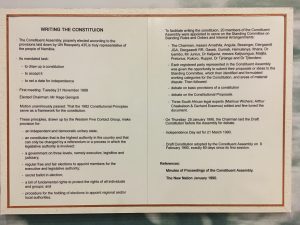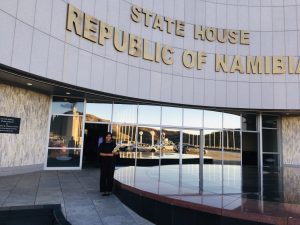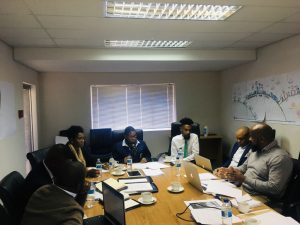By Bianca Braganza
Forging a future for Namibia, where ownership reflects the demographic of the country.
Like many days, I am the last to find out not only what I am to do for the day, but more pressingly, where I am to do it. It’s one of my favourite parts of the job- the excitement and unpredictability each day will bring.
We had barely arrived at the Commission’s office, when we received frantic calls that I was to go immediately to the State House, to accompany the Chairperson and the lawyers working on the National Equitable Economic Empowerment Framework (NEEEF). Scattered, I grabbed all the files I could, put on my nice spare shoes I keep at the office and ran out. As we raced through congested streets, I ran over the key points, strengths and weaknesses of the national economic strategy that I had amassed during my research and writing thus far.
Yet I couldn’t help but draw a blank when the massive golden gates of the President’s headquarters opened… the beauty and magnificence of the expansive white building, the golden Oryx, bright green foliage and marble encasing the main State House itself was simply breath taking.
But back to business (literally). I have spent much of my internship researching and writing reports and strategic plans on the core theoretical structure and implementation of financial instruments, for the equitable economic framework in Namibia. This required conducting cross-jurisdictional analyses predominantly with South Africa, but also with Malaysian and Canadian economic strategies that sought to incorporate and address racial disparities in accessibility and ownership within domestic markets.
The principle at the core of Namibia’s NEEEF policy is black economic empowerment. Inspiration was drawn from the Broad-based Black Economic Empowerment (BEE), which is a form of affirmative action crafted by the South African government, to address and change the economic landscape of racial inequalities of Apartheid, and increase economic participation of Black people in the South African economy. Interestingly, “black” as legally defined by the South African legislation encompasses African, Coloured, and Indian persons who are citizens of the country. Turning to the Namibian context, the purpose of legislation, reports and strategies based on NEEEF is to forge a future for Namibia where ownership reflects the demographic of the country. Much of this includes learning from the South African implementation of BEE and why the country struggled in practice to achieve the outcome of racial economic transformation that they originally had envisioned.
Namibia is only 29 years old, gaining independence from South Africa in 1990. The constitution of Namibia was created not by an act of Parliament, but rather as a negotiated settlement- a peace treaty, essentially- to secure independence. In effect, it solidified the ways in which the country’s economic landscape would be shaped and the way it would remain present day. Importantly, property as it was during Apartheid remained unaltered. Furthermore, constitutional provisions (for example, property under Article 16(1)) were created during this peace negotiation that protected property owners as they stood under Apartheid.

If you grocery shop, or buy commodities, you will see that the previously disadvantaged majority (hereafter PDM; as defined under NEEEF means “victims of Apartheid policies”) occupies the lower level positions: sales representatives, cleaners, and public facing staff. However, ownership and controllership of those very firms, the upper management levels, are mostly held by the previously advantaged minority (PAM) Namibian population. In Namibia, there are a few owners of larger enterprises that own a monopoly on the major chains in Namibia- Pick and Pay (groceries), Pupkewitz (cars) and Shoprite (merchandise) for example.
The main challenge now remains, 29 years after independence, how do we shift the economic landscape to be more reflective of the actual demographic composition of the people of Namibia? Perhaps more importantly, how do we have more PDMs owning and controlling the economy and do so legally, in accordance with the constitution as it currently stands, unamended since Independence.
The basis upon which NEEEF operates is within government procurement. Corporations that do business with the government that meet certain compliance standards and statistical thresholds within employment and ownership of previously disadvantaged majority persons, are favoured. There are five pillars under which enterprises will be evaluated for procurement with government: Ownership, Management Control and Employment Equity, Human Resources and Skills Development, Entrepreneurship Development and Community Investment. A scoring system is enacted whereby, for example under the Ownership Pillar, “a business will score a minimum of 10 points if it is 25% owned by previously disadvantaged Namibians. For every additional 7.5% owned by previously disadvantaged Namibians, a business will score 1 additional point up to a maximum of 100% giving a total of 20 points“. Long term, the goal is for PDMs to not only own shares in companies, but to own enterprises themselves.
Much of a Nation’s independence is not simply political, but economic emancipation from external international access and controllership of the economy. In the Namibian context, if you drink water, eat chocolate or even moisturize with lotion, turn the product and you will invariably see “Product of South Africa”. Despite Apartheid being over, South Africa dominates the Namibian economy through the reliance on their exports for goods in the country. In light of this, NEEEF also holds the potential to reduce import reliance and create a foundation for domestically producing commodities here in Namibia, and even long term to create an export economy for the country.
The NEEEF is a revolutionary attempt to achieve economic prosperity for the country by economically empowering and providing tools and financial instruments to those persons that were socially, educationally, and economically disadvantaged as a result of Apartheid. It provides the basis for a new vision of the country, based on social economic transformation to enhance equity, accessibility and ownership of the previously disadvantaged majority population.


